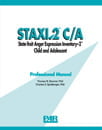
State-Trait Anger Express Inventory-2 Child and Adolescent staxi-2-ca
For: Assess state and trait anger with anger expression and control
Reading Level: Ages 9 to 18 years
Format: Paper-and-Pencil
Length: 10 minutes
Scoring: Hand Scored
Printed Kits
Click to browse products
Printed Forms & Handscoring Materials
Test forms, response booklets and scoring reference manuals.
STAXI-2 C/A Introductory Kit
STAXI-2 C/A Profile Forms (25)
STAXI-2 C/A Rating Booklets (25)
Authors
Thomas M. Brunner, PhD and Charles D. Spielberger, PhD
Description
The STAXI-2 C/A is a 35-item self-report measure designed to detect anger in children and adolescents ages 9 to 18 years. Based on the adult version of the instrument, the State-Trait Anger Expression Inventory-2 (STAXI-2), the STAXI-2 C/A is sensitive to the developmental aspects of anger in children.
Like its parent version, the STAXI-2 C/A assesses both state and trait anger along with anger expression and control. The STAXI-2 C/A expression and control scales assess important dimensions that facilitate the evaluation and the subsequent placement of children with specific problem behaviours into groups based on distinguishable temperaments and/or externalising or suppressive coping styles.
Special Features of the STAXI-2 C/A
Distinguishes temporary anger states from more trait-like or enduring conditions (e.g., whether a temper tantrum is a hallmark of a personality trait vs. a transient state-like event).
Enhances the ability to assess and diagnose the spectrum of conditions in which anger intensity as an emotional state is important (e.g. bipolar disorder, intermittent explosive disorder, reactive attachment disorder, oppositional defiant disorder, post-traumatic stress disorder).
Assesses the degree to which a child reacts only to specific negative events or more generally responds to diverse environmental events.
Assesses a child’s habitual anger coping style as either externalising or internalising (i.e. suppressive).
Assists in the determination of whether key aspects of a child’s anger profile may be related to problems with their health status (e.g. problems exacerbated by intense and/or frequent anger suppression).
Written at a 4th-grade reading level, the STAXI-2 C/A Rating Booklet is tailored for use by children and adolescents.
Reflects the 2007 U.S. Census population parameters via a post-stratification weighting procedure that was applied to the STAXI-2 C/A normative sample of 838 public school children and adolescents.
Provides raw score to percentile and T-score conversions for the STAXI-2 C/A scales and subscales for both the total normative sample and the six normative age-by-gender groups.
Presents discriminant and convergent validity based on correlations with the Achenbach Youth Self-Report (YSR) DSM-Oriented and Syndrome scales for a subset of the normative sample and a clinical sample.
The STAXI-2 C/A may be used as part of the diagnostic process, as a tool for monitoring the long-term effects anger may have on children and adolescents, and as a complement to threat assessment measures and procedures in a variety of settings.
Overview of the STAXI-2 C/A Scales and Subscales
Scale/Subscale
Description
State Anger (S-Ang)
Measures the intensity of angry feelings and the extent to which a youth feels like expressing anger at a particular time.
State Anger-Feelings (S-Ang/F)
Measures the intensity of the angry feelings a youth is currently experiencing.
State Anger-Expression (S-Ang/VP)
Measures the intensity of current feelings related to verbal or physical expressions of anger.
Trait Anger (T-Ang)
Measures how often angry feelings are experienced over time.
Trait Anger-Temperament (T-Ang/T)
Measures the disposition to experience anger without specific provocation.
Trait Anger-Reaction (T-Ang/R)
Measures the frequency that angry feelings are experienced in situations that involve frustration and/or negative evaluation.
Anger Expression-Out (AX-O)
Measures how often angry feelings are expressed in verbally or physically aggressive behavior.
Anger Expression-In (AX-I)
Measures how often angry feelings are experienced but not expressed
Anger Control (AC)
Measures how often a youth tries to control the inward or outward expression of angry feelings.
NB: Prices are in Australian dollars inclusive of GST. NZ customers need to log in to view ex-GST prices.



